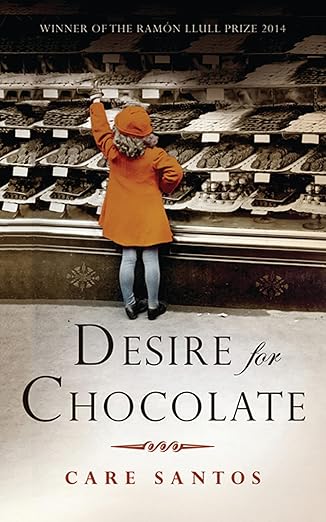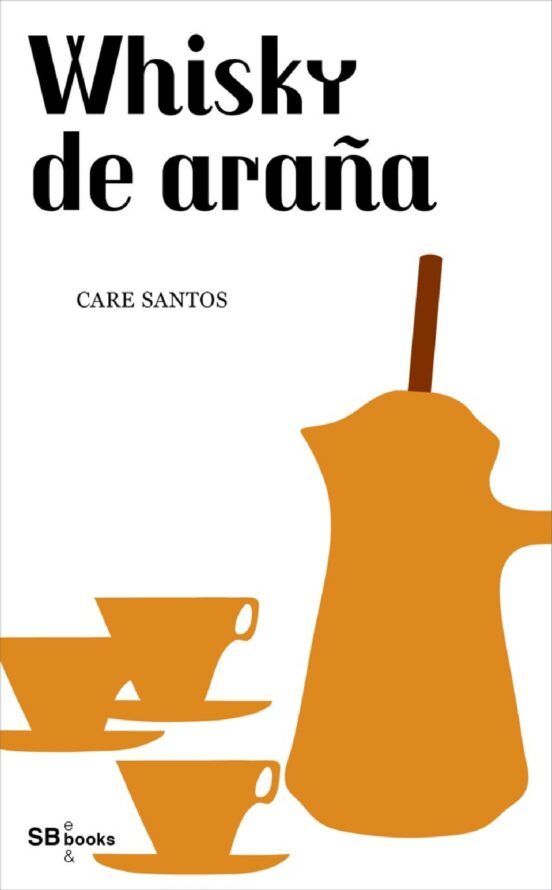A story of love and passion lived by three women in different eras, whose lives are intertwined by an antique porcelain chocolate pot… and, above all, by the fascinating history of chocolate in Europe. A bestselling drama by internationally acclaimed author Care Santos, perfect to stir emotions and get swept away.
The Desire For Chocolate Saga consists of two compelling novels: Desire For Chocolate, made up of three stories set in Barcelona, featuring three different women in three different time periods, and Whisky de araña, a short novel that picks up the characters from the first story where it left off.
In Desire For Chocolate Saga, the story begins in the 21st century and moves backward to the 18th, connected through the journey of a fine porcelain chocolate pot that once belonged to the daughter of Louis XV of France. This narrative thread introduces us to the evolution and development of chocolate production in Barcelona —from today, through its modernization and industrialization in the 19th century, back to its arrival in Catalonia in the 18th century— told through three heart-wrenching love stories.
In the first story, set in present-day Barcelona, Sara is a woman in her 40s who runs a pastry shop in the city center. Even though she has a job she loves, a wonderful husband, Max, and lovely children, she feels her life has been monotonous for 20 years, only feeling truly alive when she’s with her secret: her lover Oriol, whom she’s known since they were 20 —and who also happens to be Max’s best friend. Everything turns upside down when Oriol, now a prominent figure in the gastronomic industry, calls to say he’s coming to dinner… to announce that he’s married and moving to Japan.
At the peak of the conversation, Sara’s porcelain chocolate pot shatters on the floor —along with the possibility of a life with Oriol— but she repairs it with Max, as she feels she has always done with her life.
Throughout the pages, we discover the story of this love triangle from their youth to the present, filled with ups and downs, passion, and secrets.
In the second story, set in 19th-century Barcelona, we meet Aurora, a woman married to the esteemed doctor Horacio Volpi. But her background couldn’t be more humble: orphaned and raised by the wealthy family her mother once worked for, she was taken in to keep their daughter Cándida company.
As adults, Cándida still uses Aurora as a confidante, and Aurora supports her when she becomes engaged to the son of a prominent chocolate-making family, the Sampsons. Cándida even asks for help continuing an affair with a famous opera singer. When the scandal erupts, the family fires Aurora for keeping quiet. Wounded and furious, Aurora steals a valuable porcelain chocolate pot —a relic from Louis XV’s daughter— as her only act of revenge.
Yet fortune sometimes favors the deserving. Aurora becomes the housekeeper for Doctor Horacio Volpi, a wise and respected older man. Over time, they become more than just employer and employee, and Horacio proposes to her, defying social conventions.
For the first time, Aurora feels she is exactly where she belongs: with someone who values her for who she truly is.
In the third story, set in the 18th century, Mariana is the widow of Mr. Fernández, Barcelona’s most prominent chocolatier, internationally known for inventing a machine that simplifies the chocolate-making process. And everyone wants that machine.
Guillot, a young French secretary, is sent from the court of Versailles with a fine porcelain chocolate pot as a gift for Mr. Fernández, hoping to persuade him to reveal the secret of his invention. But upon arriving in Barcelona, the pot is stolen, and he discovers that Mariana’s husband —whom she had tried to pretend was still alive— is actually dead, and she’s fighting tooth and nail to keep the business alive on her own. On top of it all, many people are determined to get the secret to chocolate production and will stop at nothing to obtain it.
After several robbery attempts, Guillot, now smitten with Mariana, does everything in his power to help her and finally convinces her to return with him to Versailles, where she can truly flourish as the spectacular chocolatier she is.
In Whisky de araña, this brief 30-page book returns to the story of Sara, Max, and Oriol. Several years have passed since the end of Desire For Chocolate, and Sara and Max’s children are now grown. Then Max receives another call from Oriol: he’s in the hospital after suffering a stroke.
At first, Oriol cannot speak or move as before, but he gradually begins to recover. Still, Sara avoids going to see him. She still doesn’t know where to place her story with Oriol.
Hoping to keep her distance, Sara doesn’t expect to face him again at a gala where they’re to receive an award for their contribution to Catalan gastronomy —both Oriol and her. Max arranges a dinner without telling them and leaves them alone. It is then that Oriol confesses he’s never stopped wondering what would have happened if he had been brave enough to choose a life with her. But when Max returns, he makes them both a new proposal: to leave the past and “what could have been” behind and focus on the present and on what the three of them can still be —friends. The ending is left open, with Sara and Oriol contemplating this new possibility, but everything suggests they will say yes.
KEY INFORMATION:
The Desire For Chocolate Saga is one of the most successful in all of Catalan literature. It has been translated into over a dozen languages, and its author, Care Santos, has received numerous awards, including the Premio Nadal, Premio Barco de Vapor, Premio Ramón Llull, and the Premio Edebé for Young Adult Literature.
Desire for chocolate is a story full of passion and epic love, rich in plot and melodramatic touches. It’s beloved by readers, especially for its strong, ambitious, passionate female characters and its commitment to historical accuracy —well-documented and blending fiction with reality (introducing real characters while basing fictional ones on historical figures).
Another standout feature of the first novel is its narrative structure: each part has a different narrator. The first act is told in third person, the second in second person, and the third uses the epistolary format and even includes a chapter written as a play.
This saga stands out for placing gastronomy at its center —specifically, chocolate. It recalls great films where food plays a central role, such as Chocolat, The taste of things, or Julie & Julia.
Critical praise and reviews say:
“Reading the novel will not only make you crave a hot chocolate, but you’ll also learn how cacao came to Europe and how it evolved into the sophisticated treat we enjoy today.” – Goodreads
“A delicious story that will captivate you from start to finish.” – Lecturalia
AUDIOVISUAL POTENTIAL: TV Series, Miniseries, Feature Film, TV Film.
AVAILABLE LANGUAGES: Spanish, English, Catalan, French, Italian, Portuguese, German, Danish, Swedish, Finnish, Polish, Romanian, Bulgarian.
Adquirir los derechos
Para ponerte en contacto con nosotros completa el siguiente formulario y te responderemos en breve.
Error: Contact form not found.



